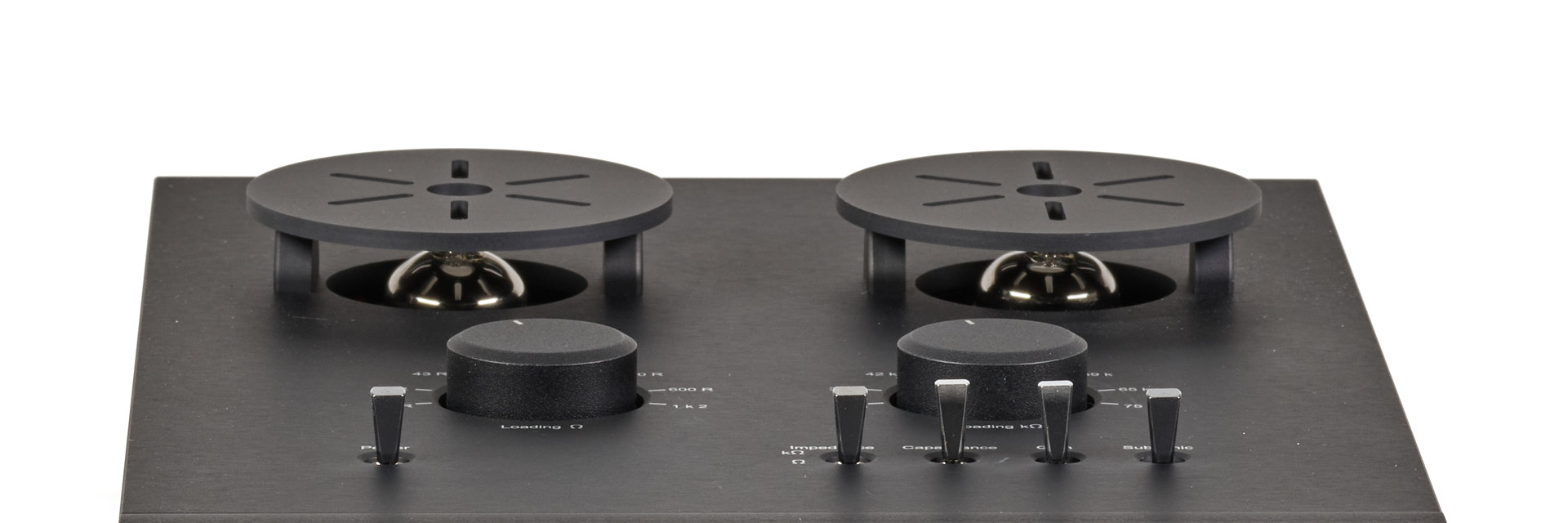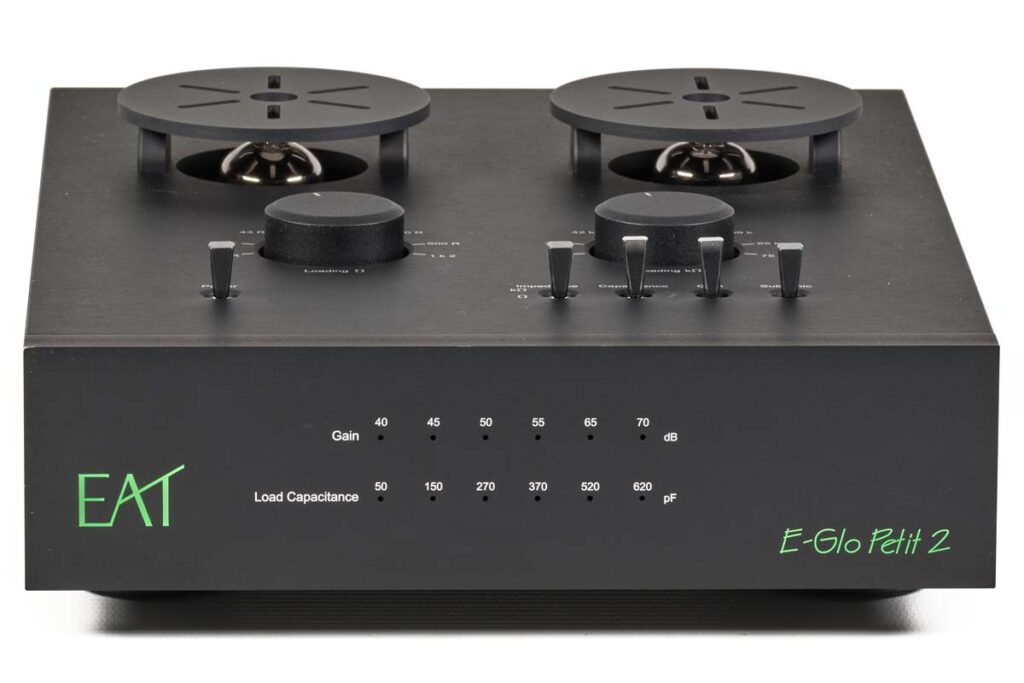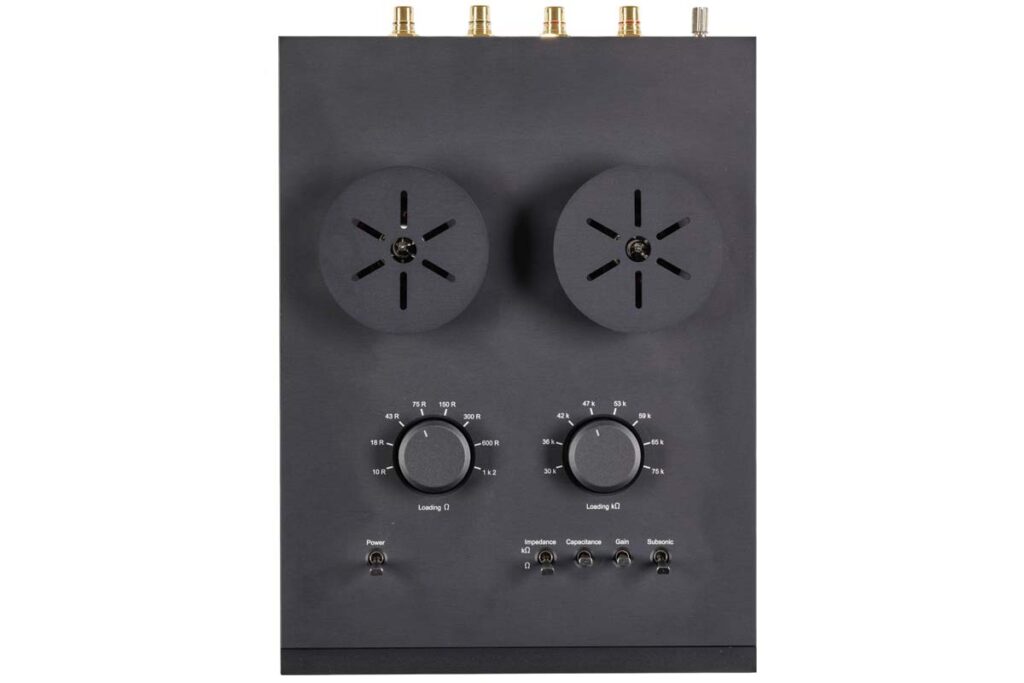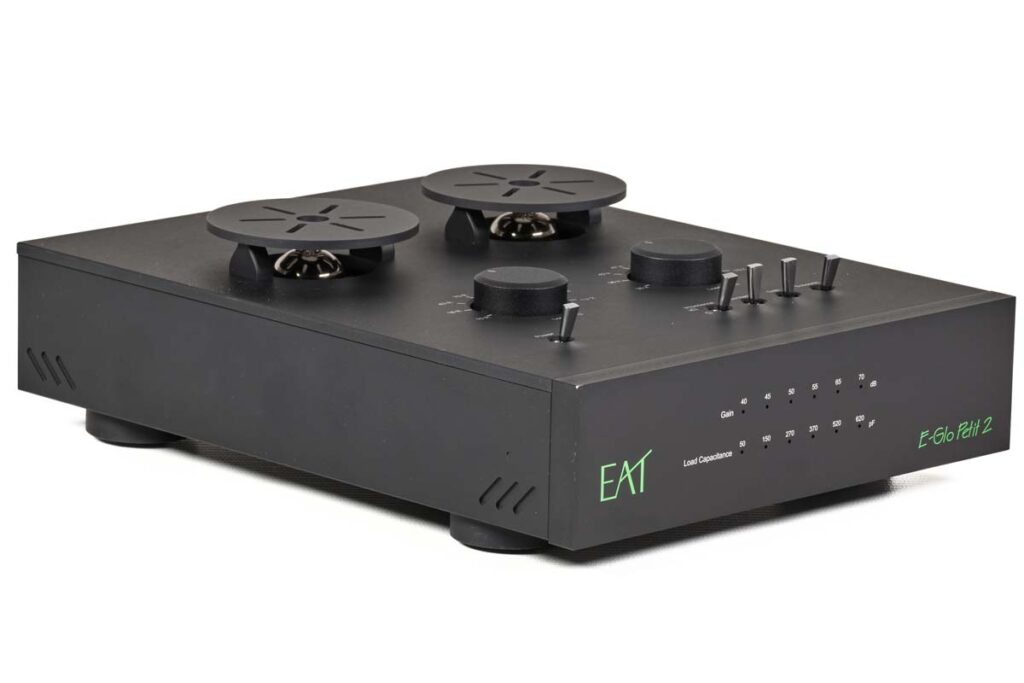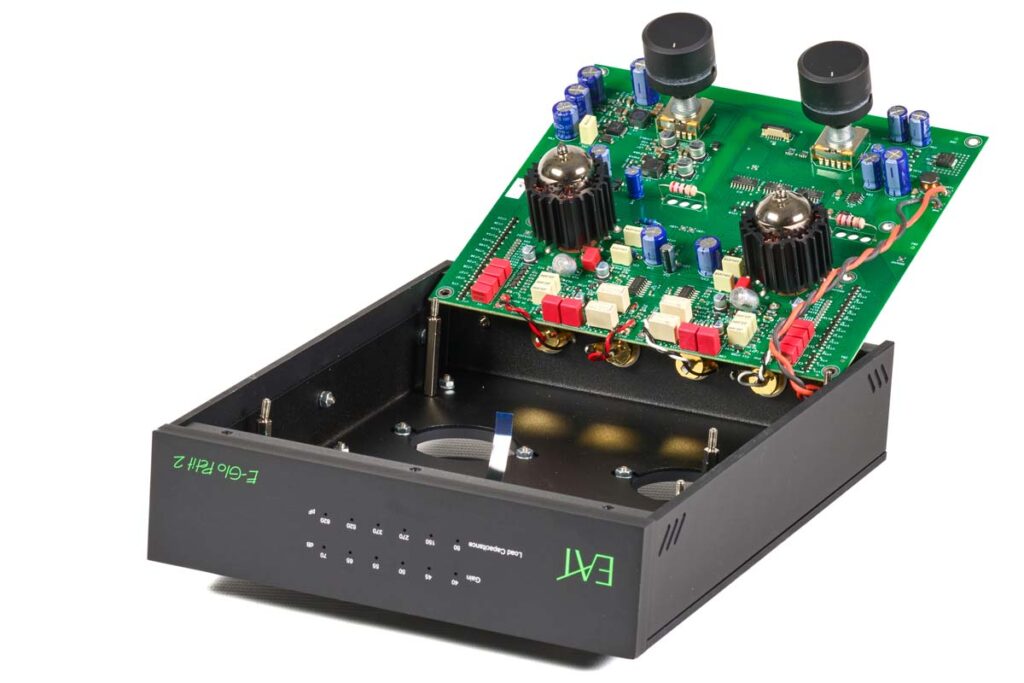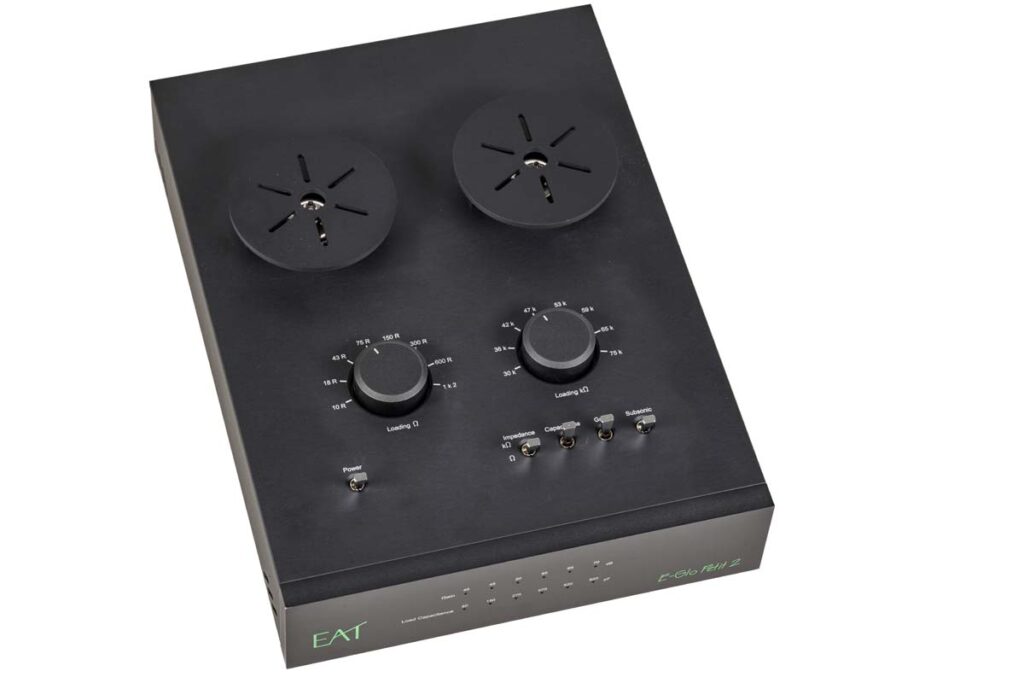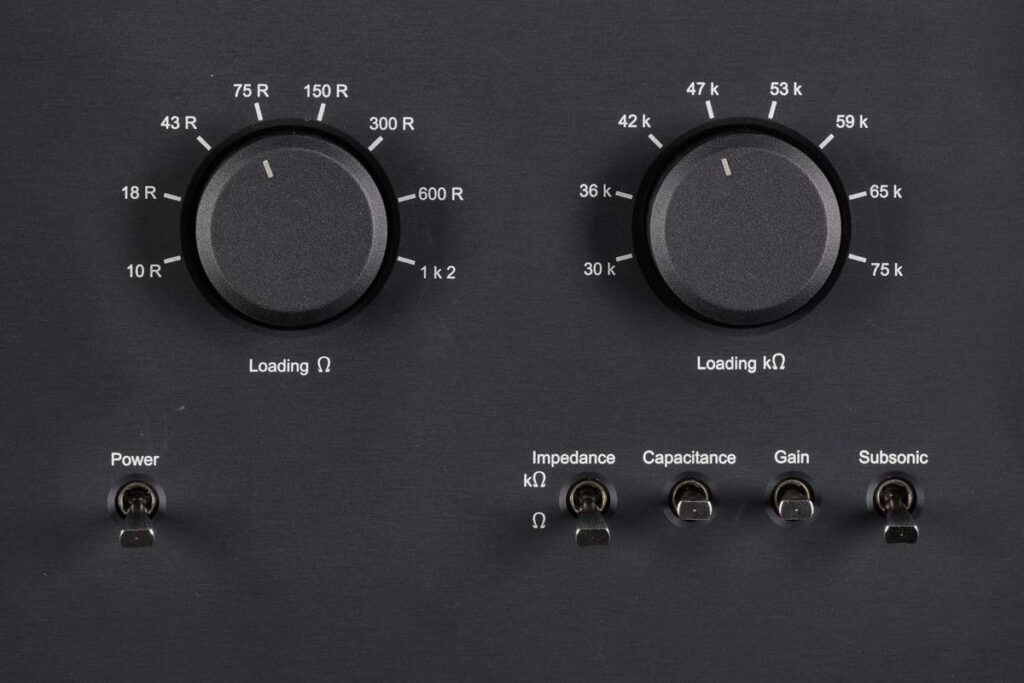Time and again, we come across devices that amaze us right from the very first note. All too often, this happens mainly in the higher price ranges. When an affordable device provides the same “Wow!” experience, however, even spoiled hi-fi gourmets are hard-pressed to hold back their enthusiasm. Read here why that’s how I felt about the phono amplifier in question …
“The European Audio Team (E.A.T. for short) stands for top audiophile quality, perfect design and pioneering innovation,” according to the manufacturer’s marketing department. Under the direction of Jozefina Lichtenegger, the E.A.T. products made in the Czech Republic have been causing quite a stir within the scene for years. Not only some of the company’s turntables, but also the large E-Glo S phono preamplifier in particular, have impressed specialist audiences worldwide. Now the EAT E-Glo Petit 2 has hit the market – and I can tell you right away that it’s very reasonably priced in its second generation. Analog enthusiasts will see at first glance that this amplifier that has it all – in the truest sense of the word. Under the two metal shields are two ECC 83s, which are kept permanently ready for use by the specially developed power supply unit. Permanently? Indeed – after reaching out to the manufacturer, we received the following answer: “Yes, the tubes remain at a constant temperature/heated. This is no reason to worry with low-power tubes such as the 12AX7, as their service life is very long, but it delivers optimum performance immediately without any warm-up time.” Furthermore, the searching eye immediately recognizes the two tube dampers fitted as standard. For E.A.T., tubes are an in-house product anyway – in line with the brand philosophy of “Handmade in Europe”. Of course, this in-house production also has its very own history. During her studies at the University of Economics in Bratislava, Jozefina Lichtenegger worked part-time at the tube manufacturer Vaic in various areas from production to marketing. She acquired a deep understanding of the production of reinforcing glass bulbs and the underlying technology. When Alesa Vaic later closed his company, the resourceful young lady found a way for her customers to produce the desired tubes at the Tesla plant in Vršovice. She would later go on to acquire this production facility with an area of around 450 square meters – with the exception of the production of transmitter tubes. Since then, the production of various tube gems has been carried out there by the highly qualified workforce that was taken over. There you go – tubes made in Europe!
The name Lichtenegger immediately rings a bell with the knowledgeable hi-fi fan, as Jozefina’s husband, Heinz Lichtenegger, is known as the head of Pro-Ject Audio Systems. This is where things come full circle, as both spouses are infected by the topic of music reproduction – and each has been doing their thing successfully for years. Jozefina Lichtenegger and the European Audio Team pay particular attention to extremely high quality in combination with their own design ideas.
Back to the review candidate. I can tell you right away that E.A.T. was able to achieve amazing sound quality for the price with this completely discrete design without any OP amps. As soon as you switch it on and set it to the necessary parameters of the pickup system involved, the “little phono” immediately starts playing with a joy that is truly inspiring. The plethora of settings is generally very easy to master, no graduation required. Features such as a subsonic filter are not always present in this price range, and the device is wonderfully self-explanatory. A quick look at the documentation for the pickup that is playing is all it takes to find the right settings, and the gain can also be adjusted on the fly – in short, E.A.T has got a lot right. This is also true for the inside.
The sound quality is achieved by the “split-passive circuit topology” and fully discrete design. The combination of JFET and tubes produces low-noise and at the same time just a little bit of distortion, but of the harmonic kind. Of course, discrete circuits are usually a bit more “direct”; I like that kind of thing. The first gain stage is a FET/tube hybrid, the second only uses FET and bipolar transistors. The power supply with its cable makes quite a simple first impression, which is why I asked the manufacturer why it looks so “cheap” compared to the device itself. “With our specially developed power supply, we have ensured that the tubes always stay ‘hot’. This ensures that they deliver their maximum performance during the entire listening session. We put a lot of time and effort into getting the power supply for the E-Glo Petit 2 just right. We believe it is a critical and important part of the signal path. Therefore, we designed it to be regulated and well filtered for better performance of the whole package. By using special low-noise 2SK209 JFET transistors in a four-circuit configuration, the E-Glo Petit achieves its incredible and unique signal-to-noise ratio of 87 decibels. No other tube phono preamplifier on the market even comes close to these values”, was the detailed answer.
I found this plausible, especially as it was clearly communicated in the further statement: “A linear power supply is certainly better than a switching power supply and has technical advantages, but reconciling good sound and good technology is always a big problem. When you design a product, you struggle with many technical compromises, as there is of course always a price cap. The best product is often the result of the best compromise. In addition, a large transformer inside the phono amplifier causes a lot of magnetic radiation, which is a big problem especially with delayed low-voltage signals, and that’s why we opted for a separate linear power supply – as with the best phono stages. A good compromise is therefore an external switching power supply and a well-designed filter stage”. Fair enough, I say!
We also wanted to know why a “version 2” is now being produced for the beautiful and solid little (aluminum) phono. The manufacturer is also very open about this and writes: “… due to the constant changes in the component market, we have used new and more up-to-date, improved components, such as capacitors.” I also ordered the EAT pickup system Jo N°5 during the test period for reasons of the manufacturer’s “Made in Europe” philosophy. For far too long have I ignored the tried and tested principle of synergy effects within a manufacturer’s range, which is why I now consciously pay attention to the effects of such constellations. The appearance of the packaging alone absolutely deserves a mention. A solid walnut box, lined with suede on the inside and fitted with integrated magnets that not only allow access to the pickup, no, the inlays themselves are also secured against falling out by small magnets. Something like this in the thousand-euro price range? Exemplary, praiseworthy, etc.! I’ve seen very different packaging for pickups. Most recently with a well-known manufacturer who, on the grounds of the “general increase in purchase prices”, replaced the former wooden pickup case with a profane cardboard box, while at the same time hiking the price of the system by a considerable amount – seriously? This kind of thing doesn’t go down well with customers at all. With the European Audio team, these little things demonstrate the attention to detail with which the boss approaches things. I really like this kind of thing, because it somehow gives the customer a feeling of appreciation for the purchase of the product. It seems to be saying: “Take a look at this …” The system itself is an OEM product manufactured by Ortofon to E.A.T. specifications – that fits in with the E.A.T. philosophy!
Looking at this truly opulent pickup body (weighing in at 15 grams), it quickly becomes clear why the cartridge should be placed on medium to heavy tonearms. In the case under review, it finds its place of work on the Transrotor TR 9S. A combination that got along beautifully already during assembly (not only because of the integrated thread in the housing). A few quick words about the mint green system body (which is already striking with its color scheme): This is produced using the latest technology in the “selective high-performance laser sintering (SLS)” process. Sounds exciting, but is a widely used technique nowadays that utilizes professional 3D printing technology in the field of plastic-based additive manufacturing options. In a nutshell: “With an SLS 3D printer, it is possible to produce polymer powder layer by layer using a moving laser beam based on a computer model (CAD data).” As for the stylus type, E.A.T opted for a “nude” fine-line stylus. As is well known, the “fine-line” is a development of the elliptical cut, in which the contact surfaces are slightly larger, which ensures better tracing within the groove. In addition, its increased contact surface results in lower distortion and record wear. The sound image is also very balanced with this type of cut.
Which brings us straight to the sonic capabilities. Out of habit, a female voice is placed on the turntable for an initial assessment. Kari Bremnes opens the musical part of the test with Norwegian Mood. Her first English-language album attracted worldwide attention almost 25 years ago. Her concise voice, integrated into jazzy and folkloristic arrangements, immediately creates a benevolent feeling in the listener, and the small phono is excellent at supporting this. It finds the smallest notes with downright sensitivity. Antonio Vivaldi’s Concerti op. 8 nos. 1-4, The Four Seasons, in the Dresden version with winds from L’Arte dell’Arco under the direction of Federico Guglielmo is a very unique interpretation of the well-known work, the sound experience of which is clearly “stunning”. The fanfare-like motifs of the “Autumn” are presented extremely sensibly by hunting horns, the “Summer” is a veritable recorder orgy, while the “Winter” is left to the strings. All highly demanding sounds that are “seen and reproduced” by the E-Glo Petit 2 as a matter of course. In keeping with the tube phono, we find music that has been preserved using analog tube recordings on an album by the Stuttgart Chamber Orchestra, Die Röhre. I can say this much: a baroque delight! Here, too, the little EAT phono never runs the risk of dropping a thing, on the contrary, my thoughts on this are more like: “Absolutely on the job!”
This brings me almost inevitably to one of the legends on vinyl: Jazz At The Pawnshop. The recording for Proprius Records is one of the best-sounding jazz recordings of the 20th century and has already been reissued by various labels in different formats. The 200 gram deluxe version is currently on rotation here, and both the LP and I are in the best of moods … So, enough of the typical “sound fetishist” talk. Let’s just keep it short: sonically, the “little phono” from the European Audio Team is clearly a big boy!
Accompanying Equipment
CD-Player: C.E.C. CD-5 Horwege | Turntable: Transrotor Dark Star Reference with Konstant Reference M1 | Tonearm: TR 9S | Cartridges: Audio-Technica VM 760SLC, Phasemation PP-200, Dynavector Te Kaitora Rua | Phono amplifier: Phasemation EA-220 | Integrated tube amplifier: MFE TA 845 SE with Elrog 284 | Speakers: Klipsch Heresy III with three crossovers each from Elixir Loudspeakers, Thivan Labs Eros 9 Ultra | Accessories: HMS, AudioQuest, MFE
Phono preamplifier EAT E-Glo Petit 2
Concept: hybrid tube phono preamplifier for MM and MC | Input impedance (low): 10, 18, 43, 75, 150, 300, 600, 1200 Ω | Input impedance (high): 30, 36, 42, 47, 53, 59, 65, 75 kΩ | Capacitance: 50, 150, 270, 370, 520, 620 pF | Output impedance: 100 Ω | Gain: 40, 45, 50, 60, 65, 70 dB | Signal-to-noise ratio: 70 dB (20 Hz to 20 kHz) | Distortion (5 mV/1 kHz, gain = 45 dB): 0.15 % | RIAA accuracy (20 Hz to 20 kHz): < 0.1 dB | Subsonic filter: 18 dB/oct. @ 20 Hz | Connections: RCA (inputs and outputs) | Power consumption (standby): 450 mA, < 0.5 W | Finishes: black, silver | Dimensions (W/H/D): 23/8/26 cm | Warranty period: 2 years | Price: around €1500
IAD
Johann-Georg-Halske-Straße 11
41352 Korschenbroich
Phone +49 2161 617830
info@iad-gmbh.de

